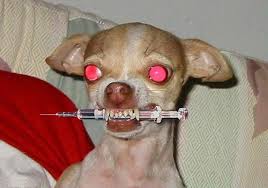
Find Out Why Your Dog Jumps Up On You And Other People: Also How To Stop It
I lost a tooth.
To be totally accurate, I lost a tooth and a half.
Not today, but a few years back when I was just starting to go into people’s homes to teach them how to train their dogs.
I will never forget this Golden Lab, her name was Clementine, a beautiful dog full of life and energy, friendly as they come and eager to play with the humans in her pack.
But that’s not what comes to my mind when I think of Clementine.
I’ll get to the what-n-why in a minute.
Clementine’s energy was the problem, it was unharnessed and unfocused, and like many dogs I have met, had no idea what to do with it, at least not in a constructive way.
I worked for ten minutes or so building trust with Clementine which wasn’t a problem she loved people to a fault and was eager to interact with me, but it was clear she was used to things being on her terms.
However she had never met someone like me before and it wasn’t long before I was making progress, I began to set the rules of engagement, and she was calming down and going with the flow much better.
I had her so she would sit for 10 seconds before moving in anticipation of the food reward. Before I came on the scene sitting was something only the people of the house did.
Clementine was not the sitting kind of dog.
Bouncing off the walls, knocking stuff over kind of dog, yes,
Sitting kind of dog,. no, her chaotic behavior knew no bounds.
If she was asked to sit, she would, but only for the fraction of a second it took for her butt to hit the floor and bounce right back up, as if her bum was spring-loaded. 🙂
I remember thinking this is going to be a piece of fried chicken, ( I know the saying is, “It’s going to be like a piece of cake”,.. but I don’t like cake”, I do however,.. looovve fried chicken.)
My cholesterol level not so much,
but it they will never know, as we are not on speaking terms right now.
But I digress…
Any hoo,..just when I thought I had this one in the bag, out comes Clementines owners who up till this point had been watching from inside the house.
The lady of the house hit the yard like a tornado, she almost ran toward me saying that she would never have believed that Clementine would be able to sit still like that if she hadn’t seen it with her own eyes.
Her excitement was electric, even I felt it.
It took all of one second for me to figure out where Clementine learned to be so hyped up and excited.
One Reason Dogs Jump Up
Dogs feel what we feel, and Clementine was expressing in a physical way (jumping up, running hog-wild around the house ect), what her owner lived everyday, and that was a chaotic life style with periodic high levels of excitement and anxiety.
It was in that moment of Clementines owner coming into the backyard that Clementine picked up on her energy and exploded from her sit position in front of me, straight up into my face.
More precisely, her big hard head,. met my pearly whites,.. in a head on tooth collision that didn’t end well for one and half of my front teeth. 😦
How To Stop Your Dog From Jumping Up
One of the best ways that I know of to get your dog to stop jumping up on you is to not reward him for the behavior, either intentionally or unintentionally.
When dogs are little we tend to meet them with excitement and joy and when the pup gets close enough we go down on one or both knees and coax him up on us to play and rough house a little.
Maybe we pet them when they jump up on us, while saying things like, who’s a good boy, what you want?, wanna get the stick?, and we throw a ball or give him treats just because he is so damn cute,..
That is the human thing to do, but in a dogs eyes this is a humongous reward and you can bet he is going to remember all the good things that came when he put his cute little paws up on you.
Fast forward 18 months and things are not so rosey, he now weighs a heck of a lot more than he did when he was 12 weeks old, and now when he greets us by jumping up, he can hurt us and wreck clean clothes.
Your friends and family stop coming for visits.
You try your best to get him to stop, you try every thing you can think of,
Yelling, scolding, turning your back, maybe even giving him a scruff up side the head, but nothing works.
All these attempts to stop your dog from jumping up on you are in and of themselves,..rewards..all be it..unintentional and negative in nature.
One of the ways to begin to fix this problem, is to take stock of the situation and make changes in your behavior in order to influence your dogs behavior.
Remember I said earlier that your dog feels what you feel, so with that in mind ask yourself these questions.
1- Do you act excited to see your dog when you come home?
2- Are you getting angry with your dog in those times when he jumps on you?
If you answered yes to either of these questions then you have to do some inward looking and try hard to not give your dog attention either positive or negative when you first greet them.
Instead of acknowledging your excited dog when you come home, ignore him and go about work with other chores, like getting supper ready or making a cup of coffee.
Ignore your dog like he was not even there, don’t look at him, don’t talk to him, and don’t touch him.
When you dog is calmer then you can say hello, don’t look them straight in the eye because this will cause more anxiety in an already hyper excited mind.
Call your dog to come and at the moment you know he is going to jump on you, look him right in the eye and say,.. “NO!! .. in your best I mean it voice, show your teeth, turn sideways, and don’t move.
When you show a dog your teeth it speaks volumes to the dog in his native language.
You see,..
Dogs are repelled by predators, especially if they are showing teeth and looking them right in the eyes,..
As far as predators go, humans are top of the pile.
Don’t take a step backward because this will only make him want to jump on you more.
Stand still,.. be the rock,.. and if he jumps up,.. let him,.. and when he gets no response,.. either positive or negative,.. he will soon learn that there is no reward in jumping up and he will stop.
Remember the more a dog gets rewarded for a behavior the more likely he is to repeat that behavior often.
As long as you stay consistent with minding your own energy,.. and be aware of the way you feel,.. couple that with providing no reward for your dog,.. before long jumping up will be a thing of the past.
If your dog is rebellious and refuses to respond, then remove him from the room and give him a 1 minute time out in a place where he has nothing to do but wait for you to come and get him.
Short time outs are a very effective method of learning for a dog.
Dogs are very social animals,.. and they don’t like being isolated from the rest of their pack, this will help the learning process move more quickly.
Teach your dog to sit, there are literally a hundred things your dog can’t do when he’s sitting,.. and you guessed it,..jumping up is one of them.
Your friends and family will be so impressed, and relieved,.. they will once again want to spend time with you and your good dog.
Be sure to teach everyone how to do this exercise with your dog.
If your dog is behaving like Clementine and has free run of the house,.. your first order of business should be to crate train your dog.
Not only does crate training allow your dog to have place of their own to sleep and feel safe, the crate is a great tool for managing unwanted behavior while you teach your dog the rules of the house.
Talk soon,
Harley





 I am often called to help people who are struggling with a dog that just won’t calm down,.. inside the house or out..the door bell rings and they steam roll anything in their way to get the door barking and jumping.. and have to be pulled away by the collar. One of the best things anyone can do to ensure peace and harmony is to train the dog to go to a mat or bed, lay down, stay there.. and be quiet..
I am often called to help people who are struggling with a dog that just won’t calm down,.. inside the house or out..the door bell rings and they steam roll anything in their way to get the door barking and jumping.. and have to be pulled away by the collar. One of the best things anyone can do to ensure peace and harmony is to train the dog to go to a mat or bed, lay down, stay there.. and be quiet..








